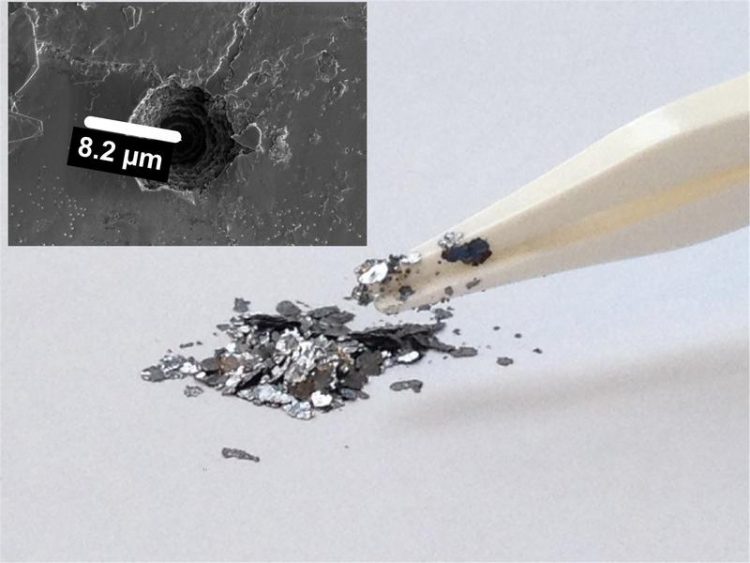Low-cost battery from waste graphite

Kish graphite is a waste product from steel production. It could be used to make a cheap rechargeable battery out of abundant materials. Empa / ETH Zürich
Kostiantyn Kravchyk works in the group of Maksym Kovalenko. This research group is based at both ETH Zurich and in Empa’s Laboratory for Thin Films and Photovoltaics. The two researchers’ ambitious goal at the Empa branch is to make a battery out of the most common elements in the Earth’s crust – such as magnesium or aluminum.
These metals offer a high degree of safety, even if the anode is made of pure metal. This also offers the opportunity to assemble the batteries in a very simple and inexpensive way and to rapidly upscale the production.
In order to make such batteries run, the liquid electrolyte needs to consist of special ions that do not crystallize at room temperature – i.e. form a kind of melt. The metal ions move back and forth between the cathode and the anode in this “cold melt”, encased in a thick mantle of chloride ions. Alternatively, large but lightweight organic anions, which are metal-free, could be used.
This does come with a problem, though: where are these “thick” ions supposed to go when the battery is charged? What could be a suited cathode material? By way of comparison: in lithium ion batteries, the cathode is made of a metal oxide, which can easily absorb the small lithium cations during charging. This does not work for such large ions, however. In addition, these large anions have an opposite charge to the lithium cations.
Battery turned “upside down”
To solve the problem, Kovalenko’s team had a trick up their sleeves: the researchers turned the principle of the lithium ion battery upside down. In conventional Li-ion batteries, the anode (the negative pole) is made of graphite, the layers of which (in a charged state) contain the lithium ions.
In Kovalenko’s battery, on contrary, the graphite is used as a cathode (the positive pole). The thick anions are deposited in-between the graphene layers. In Kovalenko’s battery, the anode is made of metal.
Kravchyk made a remarkable discovery while searching for the “right” graphite: he found that waste graphite produced in steel pro-duction, referred to as ”kish graphite”, makes for a great cathode material. Natural graphite also works equally well – if it is supplied in coarse flakes and not ground too finely or into folded, non-flake shapes.
The reason: the graphite layers are open at the flakes’ edges and the thick anions are thus able to slip into the structure more easily. The fine-ground graphite normally used in lithium ion batteries, however, is ill-suited for Kovalenko’s battery: by grinding the graphite particles, the layers become creased like crumpled-up paper. Only small lithium ions are able to penetrate this crumpled graphite, not the new battery’s thick anions.
The graphite cathode battery constructed from steel production “kish graphite” or raw, natural graphite flakes has the potential to become highly cost-effective. And if the first experiments are anything to go by, it is also long-lasting. For several months, a lab system survived thousands of charging and discharging cycles.
“The aluminum chloride – graphite cathode battery could last decades in everyday household use,” explains Kravchyk and adds “similar demonstrations, but further increased battery voltages, without compromising capacities, and of even lighter elements are on the way and will offer further increase in energy densities from current 60 Wh kg-1 to above 150 Wh kg-1”
Media Contact
All latest news from the category: Power and Electrical Engineering
This topic covers issues related to energy generation, conversion, transportation and consumption and how the industry is addressing the challenge of energy efficiency in general.
innovations-report provides in-depth and informative reports and articles on subjects ranging from wind energy, fuel cell technology, solar energy, geothermal energy, petroleum, gas, nuclear engineering, alternative energy and energy efficiency to fusion, hydrogen and superconductor technologies.
Newest articles

Sea slugs inspire highly stretchable biomedical sensor
USC Viterbi School of Engineering researcher Hangbo Zhao presents findings on highly stretchable and customizable microneedles for application in fields including neuroscience, tissue engineering, and wearable bioelectronics. The revolution in…

Twisting and binding matter waves with photons in a cavity
Precisely measuring the energy states of individual atoms has been a historical challenge for physicists due to atomic recoil. When an atom interacts with a photon, the atom “recoils” in…

Nanotubes, nanoparticles, and antibodies detect tiny amounts of fentanyl
New sensor is six orders of magnitude more sensitive than the next best thing. A research team at Pitt led by Alexander Star, a chemistry professor in the Kenneth P. Dietrich…





















